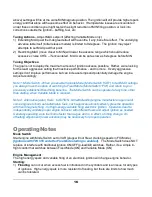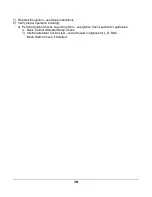
16
above) settings will fire at the same MIN/magneto position. The ignition will still provide higher spark
energy and that alone will have some effect on behavior. If temperature issues are encountered
under these conditions you might test with a slight reduction of MIN firing position, or look into
corrections outside the ignition
– baffling, fuel, etc.
Tuning Actions
– Adjust MAX setpoint
(affecting Variable Mode only)
1) Extending MAX past the 9-degree default will have little, if any, beneficial effect. The underlying
advance table itself (initial release models) is limited to 9-degrees. The ignition may reject
attempts to set MAX past that point.
2) Restricting MAX (move closer to MIN) will lower the advance range which should reduce
excessive cruise CHTs
– if encountered. MAX can be set as low as 6-degrees before MIN.
Tuning Objectives:
The goal is not to deploy the maximum amount of ignition advance possible. Rather, we’re looking
for the least aggressive setting that maximize performance - and no more. Overly aggressive
settings don’t improve performance but can increase temps and potentially damage the engine.
Adjust accordingly.
Note 1: Mode Switch - When you enable Variable Mode (Mode Switch
“VAR”) to test MAX settings,
you always have the option of switching to
Fixed Mode (Mode Switch “FIX”) and return to your
previously established fixed firing baseline. The Mode Switch can be operated at any time, other
than startup, when Variable Mode is required.
Note 2: Alternative (auto) Fuels: CAUTION - Notwithstanding engine manufacturer approval of
some engines to burn auto/alternative fuels, such approvals almost certainly presume operation
with fixed magneto firing - not high-energy variable firing electronic ignition. Operators need to
independently validate proper engine behavior with different fuels and adjust ignition as needed.
Generally speaking, auto fuel burns faster than avgas and is, in effect, a timing change. An
offsetting adjustment (lower advance) may be necessary for proper operation.
Operating Notes
Mode Switch
Start engine with Mode Switch set to VAR (plugs will not fire at cranking speeds in FIX Mode).
[Ignitions with FW V55 and after Fixe Mode starting is enabled].
The Mode Switch does NOT
replace or interfere with traditional ignition ON/OFF (p-lead/kill) switches. Rather, i
t’s a simple in-
flight control that switches between Fixed Mode (ON) and Variable Mode (ON).
Engine Management
The high energy spark and variable firing of an electronic ignition will change engine behavior.
Starting:
1)
Flooding
can occur when excess fuel is introduced in the cylinders and is an issue for all types
of ignitions. High energy spark is more resistant to flooding, but there are limits to how much
can be tolerated.




























